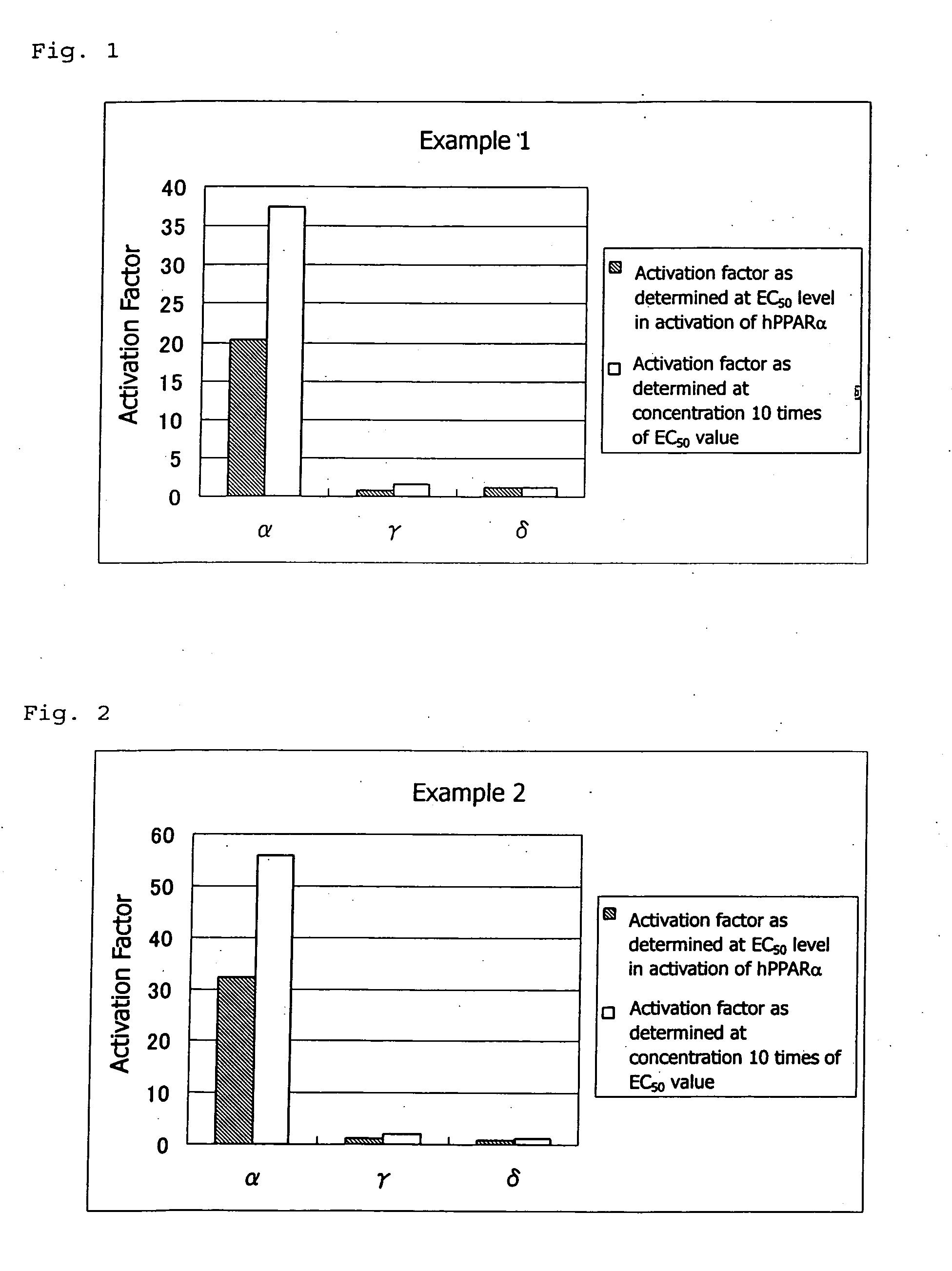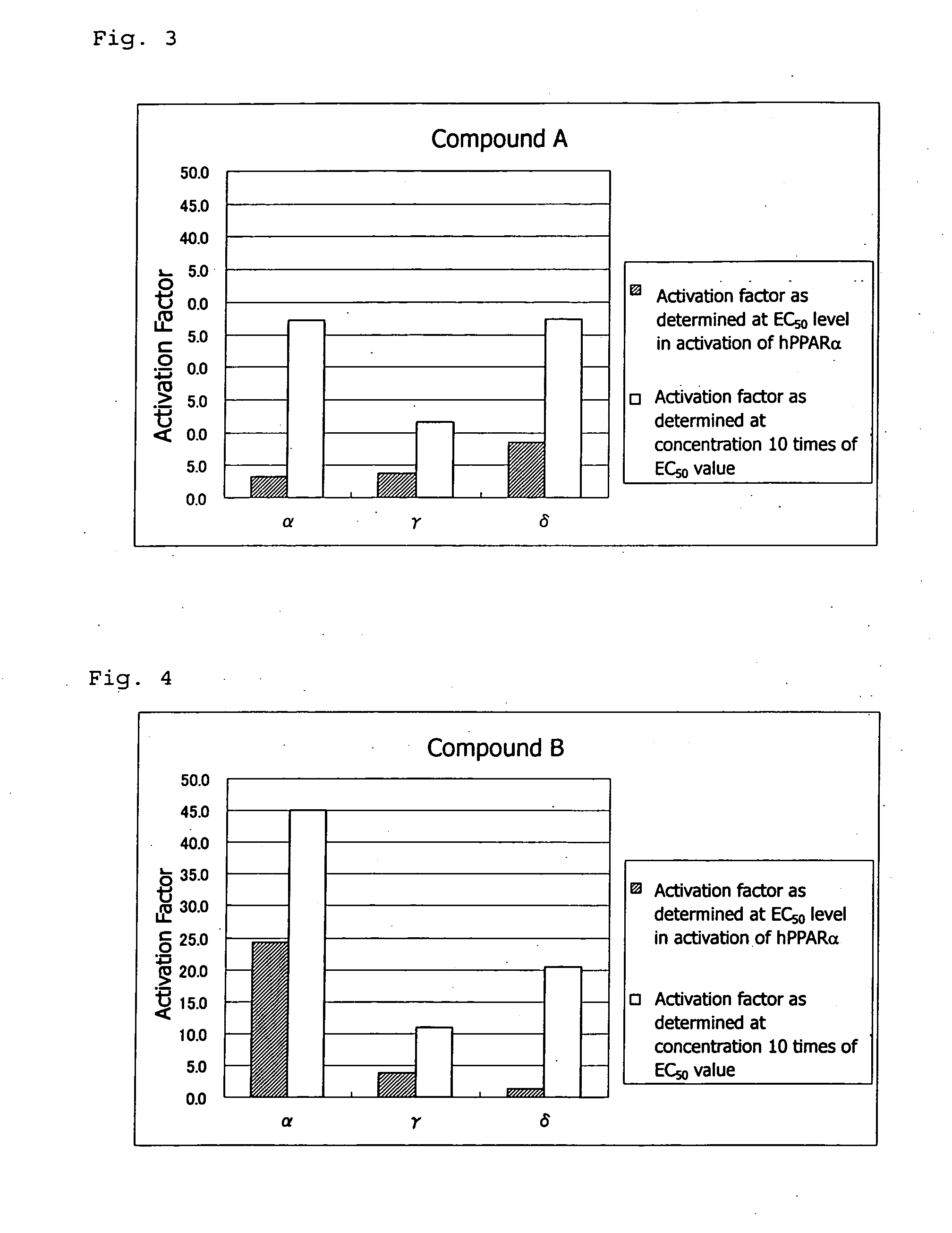PPAR-activating compound and pharmaceutical composition comprising the compound
a technology of activating compound and active compound, which is applied in the direction of drug composition, biocide, metabolic disorder, etc., can solve the problems of unfavorable effect of accumulating lipids, increase fat and body weight, and unclear biological significance of ppar
- Summary
- Abstract
- Description
- Claims
- Application Information
AI Technical Summary
Benefits of technology
Problems solved by technology
Method used
Image
Examples
production example 1
Synthesis of Ethyl 2-(3-formylphenoxy)butyrate
3-Hydroxybenzaldehyde (18.3 g, 0.150 mol) was dissolved in N,N-dimethylformamide (150 mL). Subsequently, potassium carbonate (22.80 g, 0.165 mol), and then ethyl 2-bromobutyrate (29.26 g, 0.150 mol) were added thereto, and the resultant mixture was stirred overnight at 80° C. The temperature of the reaction mixture was returned to room temperature. Ethyl acetate was added. Washing was performed sequentially with water and brine, followed by drying over sodium sulfate. The reaction mixture was subjected to filtration, concentration under reduced pressure, and purification by silica gel column chromatography (n-hexane / ethyl acetate=5 / 1), whereby a colorless oil was obtained (35.29 g, 0.149 mol, 99.6%).
1H-NMR (400 MHz, CDCl3) δ: 1.10 (t, J=7 Hz, 3H), 1.26 (t, J=7 Hz, 3H), 1.99-2.06 (m, 2H), 4.23 (q, J=7 Hz, 2H), 4.65 (t, J=6 Hz, 1H), 7.17-7.22 (m, 1H), 7.35(s, 1H), 7.45-7.49 (m, 2H), 9.95 (s, 1H).
production example 2
Synthesis of Ethyl 2-[3-[N-[3-(4-fluorophenoxy)propyl]aminomethyl]phenoxy]butyrate
Ethyl 2-(3-formylphenoxy)butyrate (5.0 g, 21.2 mmol) was dissolved in 1,2-dichloroethane (20 mL). Subsequently, 3-(4-fluorophenoxy)propylamine (4.65 g, 27.5 mmol) was added thereto, and the resultant mixture was stirred for 20 minutes. Subsequently, sodium triacetoxyborohydride (95%, 7.1 g, 31.8 mmol) and small amount of acetic acid were added thereto, and the mixture was stirred overnight at room temperature. A saturated aqueous sodium hydrogencarbonate solution was added thereto. The reaction mixture was extracted with chloroform, and the organic layer was washed with brine. The resultant mixture was subjected to drying over anhydrous sodium sulfate, concentration under reduced pressure, and purification by silica gel chromatography (chloroform / methanol=30 / 1), whereby the target compound was obtained (6.7 g, 81%).
1H-NMR (400 MHz, CDCl3) δ 1.07 (t, J=7 Hz, 3H), 1.24 (t, J=7 Hz, 3H), 1.93-2.01 (m, 4...
production example 3
Synthesis of Ethyl 2-[3-[[N-(benzoxazol-2-yl)-N-3-(4-fluorophenoxy)propyl]aminomethyl]phenoxy]butyrate
Ethyl 2-[3-[N-[3-(4-fluorophenoxy)propyl]aminomethyl]phenoxy]butyrate (6.2 g, 15.9 mmol) was dissolved in N,N-dimethylformamide (10 mL), and N,N-diisopropylethylamine (3.1 g, 23.8 mmol) was added dropwise thereto. Subsequently, 2-chlorobenzoxazole (2.9 g, 19.0 mmol) was added thereto, and the resultant mixture was stirred for 15 minutes at room temperature, followed by stirring overnight at 50° C. Subsequently, a saturated aqueous sodium hydrogencarbonate solution was added thereto. The reaction mixture was extracted with ethyl acetate, and the organic layer was washed with brine. The resultant mixture was subjected to drying over anhydrous sodium sulfate, concentration under reduced pressure, and purification by silica gel chromatography (n-hexane / ethyl acetate=4 / 1), whereby the target compound was obtained (7.5 g, 93%).
1H-NMR (400 MHz, CDCl3) δ 1.05 (t, J=7 Hz, 3H), 1.17 (t, J=...
PUM
| Property | Measurement | Unit |
|---|---|---|
| density | aaaaa | aaaaa |
| insulin resistance | aaaaa | aaaaa |
| body weight | aaaaa | aaaaa |
Abstract
Description
Claims
Application Information
 Login to View More
Login to View More - R&D
- Intellectual Property
- Life Sciences
- Materials
- Tech Scout
- Unparalleled Data Quality
- Higher Quality Content
- 60% Fewer Hallucinations
Browse by: Latest US Patents, China's latest patents, Technical Efficacy Thesaurus, Application Domain, Technology Topic, Popular Technical Reports.
© 2025 PatSnap. All rights reserved.Legal|Privacy policy|Modern Slavery Act Transparency Statement|Sitemap|About US| Contact US: help@patsnap.com



